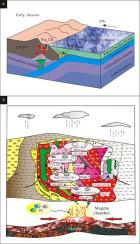Ore Geology Reviews ( IF 3.2 ) Pub Date : 2021-04-22 , DOI: 10.1016/j.oregeorev.2021.104186 Peng Zhang , Yan Zhao , Xiaochun Li , Lin-lin Kou , Zhong-wei Bi , Ren-ping Han

|
The newly-discovered Yanghuidongzi porphyry Cu deposit is located in the southeastern part of Heilongjiang Province in NE China and represents one of the rare Jurassic porphyry Cu deposits within the easternmost segment of the Central Asian Orogenic Belt (CAOB). The Cu mineralization occurs as veins and disseminations hosted by granodiorite porphyry, associated with typical porphyry copper deposit alteration zoning, which is characterized by from an inner K-silicate zone through to a quartz–sericite zone to an outer propylitic zone, the K-silicate alteration and quartz–sericite alteration are closely related to mineralization. LA-ICP-MS zircon U-Pb data, sericite Ar-Ar and Molybdenite Re-Os data, and H-O and Pb isotopic compositions are used to constrain the ore-forming age and genesis of the Yanghuidongzi Cu deposit. LA-ICP-MS U-Pb dating of zircons from three granodiorite porphyry samples yielded weighted mean 206Pb/238U ages of 194.3 ± 1.2 Ma, 192.0 ± 2.0 Ma, and 194.6 ± 2.1 Ma respectively, whereas zircon U-Pb age of granodiorite in the study area yielded weighted mean 206Pb/238U age of 199.5 ± 1.5 Ma that are interpreted to be the emplacement age of these intrusions. 40Ar-39Ar dating of sericite from a quartz-pyrite vein and a quartz-polymetallic sulfide vein yielded plateau ages of 193.9 ± 2.1 Ma and 193.6 ± 1.9 Ma, respectively, whereas five molybdenite samples yielded a Re-Os isochron age of 194.8 ± 2.1 Ma, with a weighted mean model age of 193.6 ± 1.2 Ma. Mineralization ages are consistent with the emplaced ages of the granodiorite porphyry within the analytical uncertainties, indicating that the Cu mineralization is genetically related to the granodiorite porphyry. The fluid δ18Ofluid and δ18Dfluid values range from −4.22‰ to 6.5‰ and from −92.8‰ to −65.7‰, respectively, indicating that the ore fluids were mixtures of magmatic and meteoric water. The 206Pb/204Pb, 207Pb/204Pb, and 208Pb/204Pb values of the pyrite and chalcopyrite are 17.547–18.327, 15.446–15.505, and 37.408–38.113, respectively, suggesting a common, magmatic source for the sulfur. Taking Re (6.75–29.53 ppm) data into consideration, the sources of ore-forming materials may be from a mixture of crustal and mantle sources. Combining our new data with the Jurassic regional tectonic setting, the Yanghuidongzi Cu deposit and the related granitoids formed in a compressional tectonic setting are associated with the subduction of the Paleo-Pacific Plate beneath the Eurasian continent.











































 京公网安备 11010802027423号
京公网安备 11010802027423号